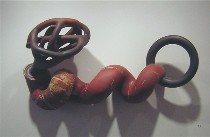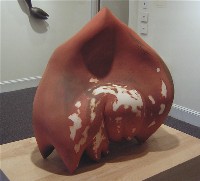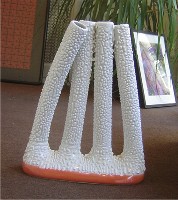 “Syd Carpenter: Remedy” at Sande Webster had me wondering just which cure Carpenter was seeking. Remedy for what? But Carpenter is never to be taken lightly. Her clay sculptures continue to raise issues–and not give answers–about race and life and memory and magic and always about people (left, “Frank Persists,” a sort of wheeled pull toy with a bobbly bird at the bottom and Frank in a hat at the top).
“Syd Carpenter: Remedy” at Sande Webster had me wondering just which cure Carpenter was seeking. Remedy for what? But Carpenter is never to be taken lightly. Her clay sculptures continue to raise issues–and not give answers–about race and life and memory and magic and always about people (left, “Frank Persists,” a sort of wheeled pull toy with a bobbly bird at the bottom and Frank in a hat at the top).The sculptures on the wall are medicinal, with a suggestion of the power of roots and plants and old-fashioned extracts and tonics. Giant talismans of primitive powers, they merge bottles with hanks of hair, vines and other plant forms, muscled limbs, medical instruments, pacifiers, toys, bandages to offer remedies to whatever ails, be it spiritual or physical woes.
 These wall pieces, anywhere from about 3 1/2 to 5 feet long, are often funny, with comic-book rubbery exaggeration of shapes–petals that look like ears, corks or plugs that look like ear plugs–and suprising, sometimes unsettling juxtapositions of forms. Give these sticks to your neighborhood shaman and let him try to shake them for good luck (right, “Blood Ties”).
These wall pieces, anywhere from about 3 1/2 to 5 feet long, are often funny, with comic-book rubbery exaggeration of shapes–petals that look like ears, corks or plugs that look like ear plugs–and suprising, sometimes unsettling juxtapositions of forms. Give these sticks to your neighborhood shaman and let him try to shake them for good luck (right, “Blood Ties”).The humor offers a kind of perspective–the ability to survive through personal strength and humor. The twisting forms call up the healing powers of nature–and magic. I have no clue whether the survival here is literal or metaphoric, but it works either way.
 While the wall pieces and one of the pedestal sculptures use a vocabulary of shapes that are close to past work from Carpenter, the other pedestal pieces are new work–a merger of sexy body shapes–hips and haunches, legs, breasts, etc.–and leaves or petals. They look like upside-down tulips. But the surfaces suggest unevenly pigmented skin–and the merger of more than one tone of flesh with another. The humor here is gone, but the clay made flesh calls out for caresses. And once again the material, the clay, with all its fragility and strength, communicates with the subject matter (left, “Remedy”).
While the wall pieces and one of the pedestal sculptures use a vocabulary of shapes that are close to past work from Carpenter, the other pedestal pieces are new work–a merger of sexy body shapes–hips and haunches, legs, breasts, etc.–and leaves or petals. They look like upside-down tulips. But the surfaces suggest unevenly pigmented skin–and the merger of more than one tone of flesh with another. The humor here is gone, but the clay made flesh calls out for caresses. And once again the material, the clay, with all its fragility and strength, communicates with the subject matter (left, “Remedy”).While I was in the gallery, I noted some unfamiliar work from Atlanta artist Eric Mack hanging in the hallway. The paintings are like aerial maps of a cityscape with jazzy rhythms of patterns, circuitboards, traffic arteries, signage and receding areas of greenery. Mack is going to be showing at Sande Webster in June. I’m eager to see more.
 Right down the street from Webster is aSFe, 2016 Walnut, and if you’re stopping at one, you should stop at the other. At aSFe, there, five ceramic artists are showing pieces, some functional, some not, but all of them more traditional than Carpenter, for whome function is utterly besides the point. Here’s a picture of a piece by Robert Sutherland Jr. (right). I loved the pimply white surface and the way the finger imagery mixed with undersea plantlife. I can’t really say it’s functional, but then again, you might come up with a use. Most of Sutherland’s work on display is functional.
Right down the street from Webster is aSFe, 2016 Walnut, and if you’re stopping at one, you should stop at the other. At aSFe, there, five ceramic artists are showing pieces, some functional, some not, but all of them more traditional than Carpenter, for whome function is utterly besides the point. Here’s a picture of a piece by Robert Sutherland Jr. (right). I loved the pimply white surface and the way the finger imagery mixed with undersea plantlife. I can’t really say it’s functional, but then again, you might come up with a use. Most of Sutherland’s work on display is functional.
On the other hand, an ironing board covered by a mosaic city-scape in non-stop competing colors by artist Jeanne Bracy, was previously functional. The show also includes an assortment of beautiful, functional pots and jars, and some ceramic word art that was stylish in its design-y color choices and use of text by Ian Anderson. The other two artists are Ryan J. Greenheck and Mark Lueders. All of them teach, Bracy, Greenheck, Leuders and Sutherland at The Ceramic Shop, and Anderson at The Clay Studio.









